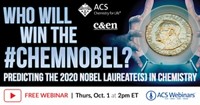Advertisement
Grab your lab coat. Let's get started
Welcome!
Welcome!
Create an account below to get 6 C&EN articles per month, receive newsletters and more - all free.
It seems this is your first time logging in online. Please enter the following information to continue.
As an ACS member you automatically get access to this site. All we need is few more details to create your reading experience.
Not you? Sign in with a different account.
Not you? Sign in with a different account.
ERROR 1
ERROR 1
ERROR 2
ERROR 2
ERROR 2
ERROR 2
ERROR 2
Password and Confirm password must match.
If you have an ACS member number, please enter it here so we can link this account to your membership. (optional)
ERROR 2
ACS values your privacy. By submitting your information, you are gaining access to C&EN and subscribing to our weekly newsletter. We use the information you provide to make your reading experience better, and we will never sell your data to third party members.
Physical Chemistry
Nobel Prize In Physics
Three honored for developing fundamental theory that explains why matter persists
by Elizabeth K. Wilson
October 7, 2008
The 2008 Nobel Prize in Physics pays homage to symmetry breaking, an abstruse but critical theory in physics that explains why matter should have persisted after the Big Bang. Developed in the 1960s and '70s, symmetry breaking also led to predictions about new types of quarks, which are subatomic particles that make up particles such as protons.
The prize will be shared by three researchers. Yoichiro Nambu, 87, of the Enrico Fermi Institute at the University of Chicago, will receive half of the $1.4 million prize for, in the words of the Royal Swedish Academy of Sciences, "the discovery of the mechanism of spontaneous broken symmetry in subatomic physics."
The other half of the prize will be shared by Makoto Kobayashi, 64, of the High Energy Accelerator Research Organization, in Tsukuba, Japan, and Toshihide Maskawa, 68, of the Yukawa Institute for Theoretical Physics at Japan's Kyoto University, "for the discovery of the origin of the broken symmetry which predicts the existence of at least three families of quarks in nature."
Nobel officials reached Kobayashi by phone in Japan during a press conference held at the Nobel Foundation, in Stockholm, announcing the prize. Kobayashi said he was "very glad" to have been honored. "It was a surprise—I did not expect it," he said.
After the Big Bang, a slight imbalance or "breaking" of symmetry between matter and antimatter particles allowed regular matter to establish its predominance in the universe. If that had not occurred, matter and antimatter would have existed in equal amounts, and the particles would have annihilated each other, professor Lars Bergstr??m, secretary of the Nobel Committee for Physics, said at the press conference. "Because of this small breaking ... we can sit here," Bergstr??m said.
Symmetry breaking also has implications for chemistry, notes Richard L. Hahn, a nuclear chemist at Brookhaven National Laboratory. "The eventual creation of the chemical elements in the early stages of the universe is tied to these processes," he says.
"It is a delight to see these seminal works recognized," adds Roy A. Lacey, president of the ACS Division of Nuclear Chemistry & Technology and chemistry professor at State University of New York, Stony Brook.
- Nobel Prize In Chemistry
- Japanese, two Americans tapped for green fluorescent protein.
- Nobel Prize In Physics
- Three honored for developing fundamental theory that explains why matter persists.
- Nobel Prize In Physiology Or Medicine
- Discoverers of HIV and cancer-causing human papillomaviruses get the nod.
- C&ENtral Science: The Chemistry Nobel … And A Rap To Celebrate It
- C&ENtral Science: The Chemistry Nobel … And A Video To Celebrate It








Join the conversation
Contact the reporter
Submit a Letter to the Editor for publication
Engage with us on Twitter